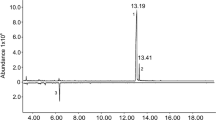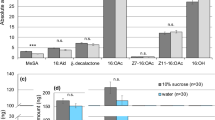Abstract
Rhyacionia spp. moths (Lepidoptera : Olethreutidae) are common pests of young pines in the Southeastern United States. Although the Nantucket pine tip moth, R. frustrana (Comstock) is usually the most prevalent species, it is often associated with the pitch pine tip moth, R. rigidana (Fernald)1,2. No previous studies have provided information on mechanisms which isolate these two species.
This is a preview of subscription content, access via your institution
Access options
Subscribe to this journal
Receive 51 print issues and online access
$199.00 per year
only $3.90 per issue
Buy this article
- Purchase on Springer Link
- Instant access to full article PDF
Prices may be subject to local taxes which are calculated during checkout
Similar content being viewed by others
References
Miller, W. E., and Wilson, L. F., J. Econ. Entomol., 57, 722 (1964).
Yates, III, H. O., Ann. Entomol. Soc. Amer., 60, 1096 (1967).
Wray, C. H., and Farrier, M. H., J. Econ. Entomol., 46, 714 (1963).
Berisford, C. W., and Brady, U. E., J. Econ. Entomol., 65, 430 (1972).
Ganyard, M. C., and Brady, U. E., Nature, 234, 415 (1971).
Roelofs, W. L., and Comeau, A., Nature, 220, 600 (1968)
Roelofs, W. L., and Tette, J. P., Nature, 226, 1172 (1970).
Roelofs, W. L., and Comeau, A., J. Insect Physiol., 17, 435 (1971).
Klun, J. A., and Robinson, J. F., Ann. Entomol. Soc. Amer., 64, 1083 (1971).
Daterman, G. E., Daves, G. D., and Jacobson, M., Environ. Entomol., 1, 383 (1972).
Roelofs, W. L., and Comeau, A., Science, 165, 398 (1969).
Wright, R. H., Nature, 204, 121 (1964).
Jacobson, M., Redfern, R. E., Jones, W. A., and Aldridge, M. H., Science, 170, 542 (1970).
Brady, U. E., Tumlinson, J. H., Brownlee, R. G., and Silver-stein, R. M., Science, 171, 802 (1971).
Roelofs, W. L., and Carde, R. T., Science, 171, 684 (1971).
Brady, U. E., and Nordlund, D. A., Life Sciences, 10, 797 (1971).
Tamaki, Y., Noguchi, H., Yushima, T., and Hirano, C., Appl. Entomol. Zool., 6, 139 (1971).
Meijer, G. M., Ritter, F. J., Persoons, C. J., Minks, A. K., and Voerman, S., Science, 175, 1469 (1972).
Author information
Authors and Affiliations
Rights and permissions
About this article
Cite this article
BERISFORD, C., BRADY, U. Specificity and Inhibition of Attraction of Male Rhyacionia frustrana and R. rigidana to their Female Sex Pheromone. Nature 241, 68–69 (1973). https://doi.org/10.1038/241068a0
Received:
Revised:
Issue Date:
DOI: https://doi.org/10.1038/241068a0
This article is cited by
-
Sex pheromone cross-attraction among four species of pine tip moths,Rhyacionia species
Journal of Chemical Ecology (1979)
-
Mutual inhibition of the attractant pheromone response by two species ofIps(Coleoptera: Scolytidae)
Journal of Chemical Ecology (1975)
Comments
By submitting a comment you agree to abide by our Terms and Community Guidelines. If you find something abusive or that does not comply with our terms or guidelines please flag it as inappropriate.



